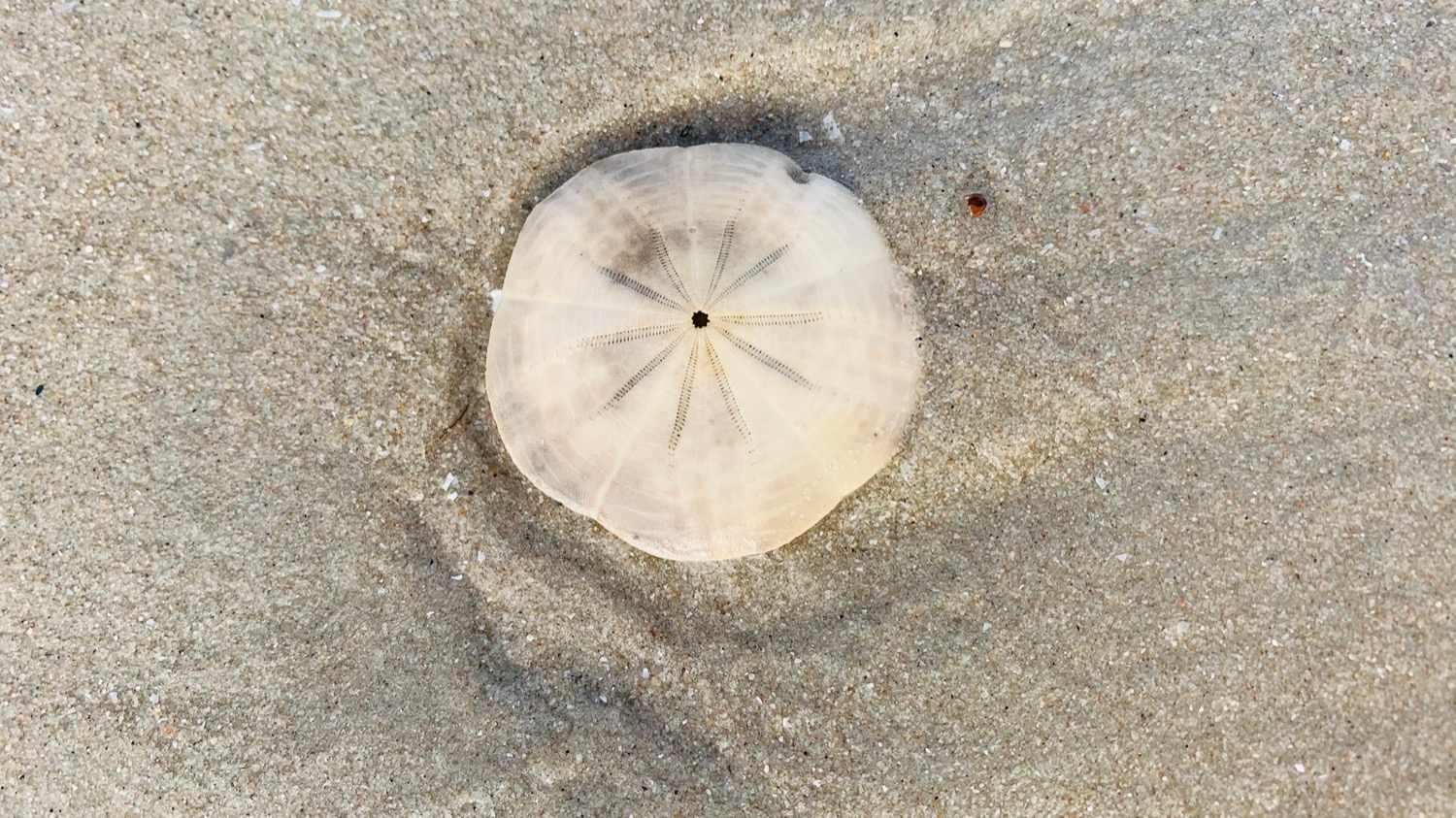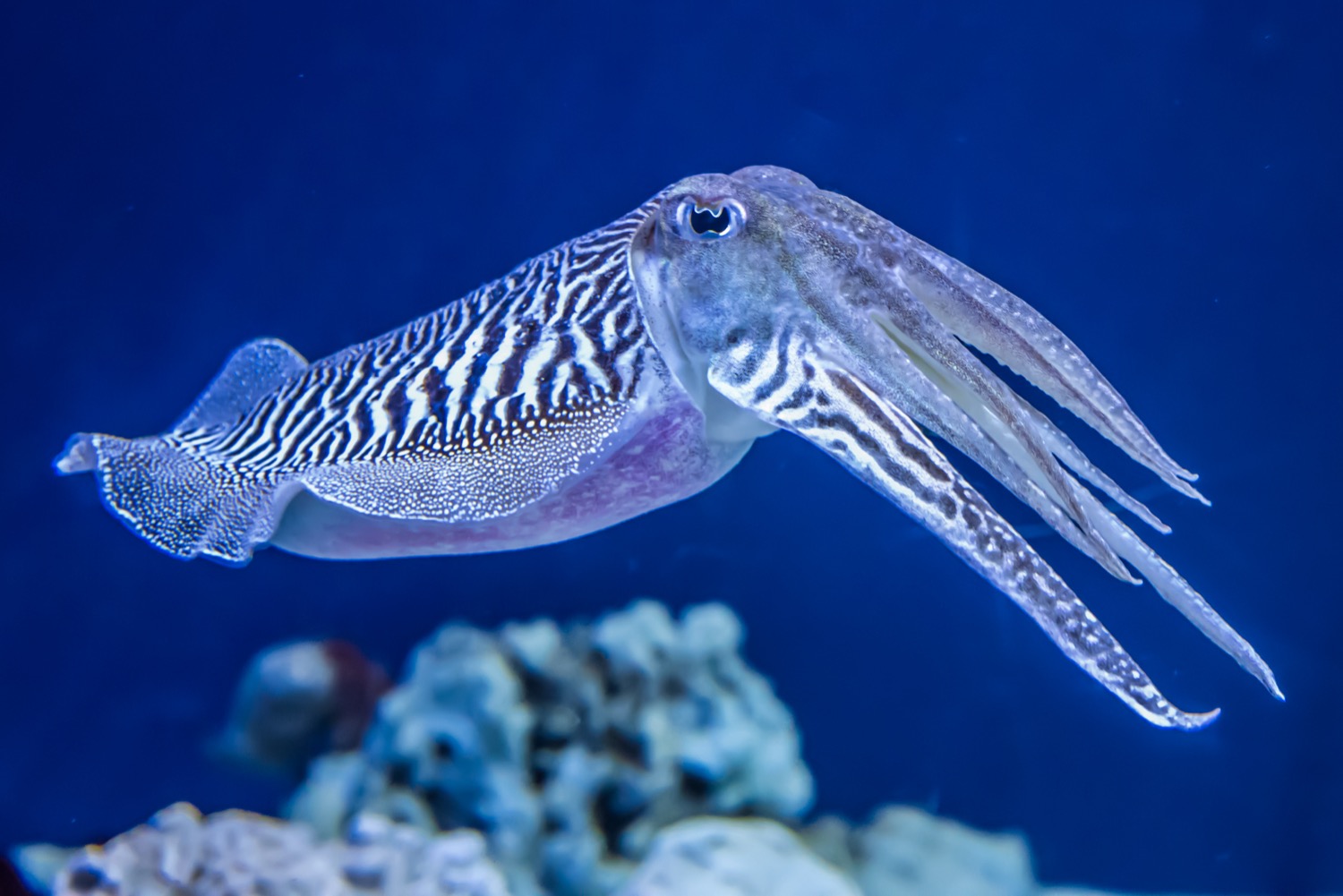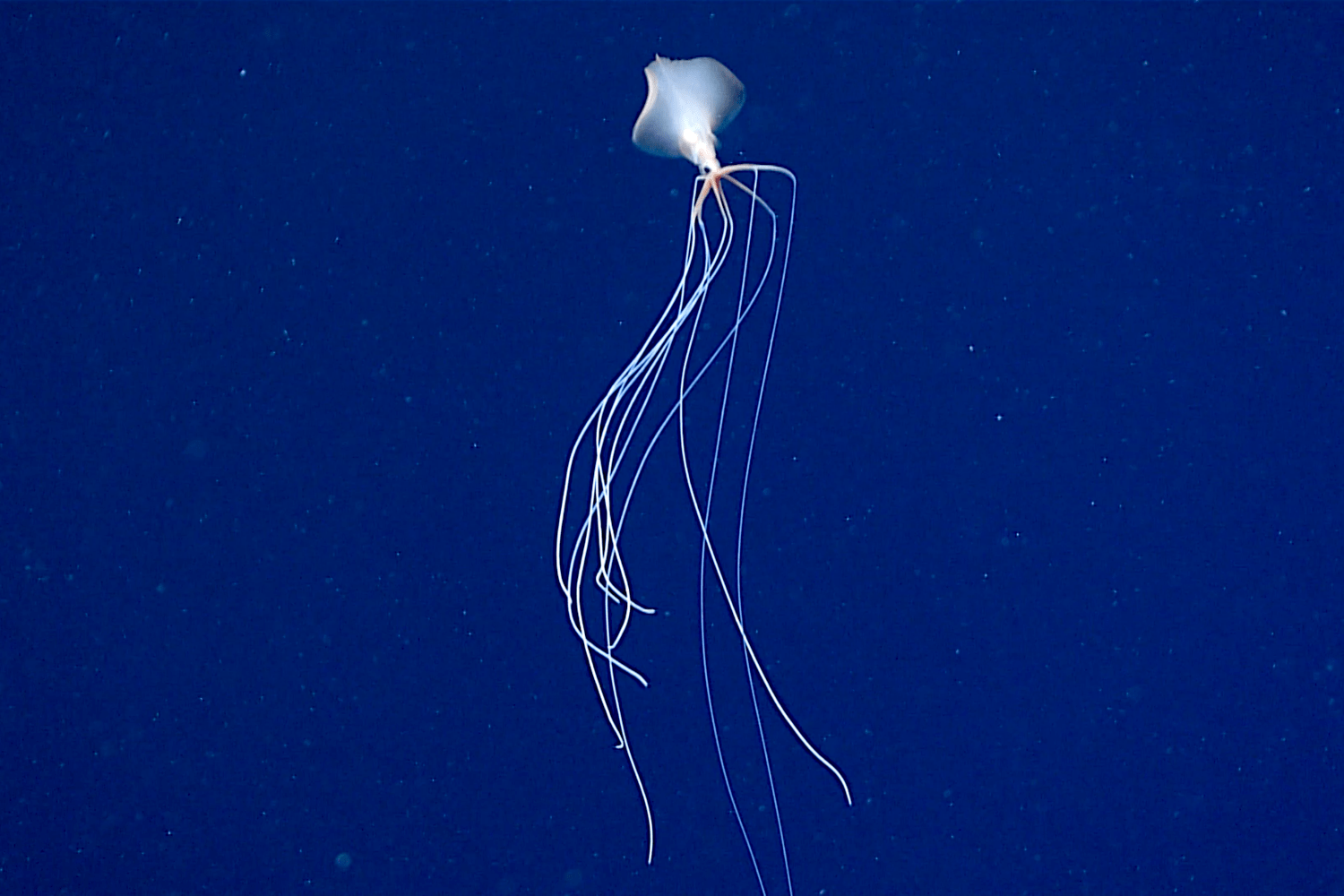The Surprising Animal Science Behind Jordan Peele’s ‘Nope’
16:45 minutes
 One of the summer’s biggest blockbusters has been the alien horror film Nope, from director Jordan Peele. Nope has elements of many classic UFO films, with the Spielbergian charm of Close Encounters of the Third Kind, and the horror and destruction from The War of the Worlds.
One of the summer’s biggest blockbusters has been the alien horror film Nope, from director Jordan Peele. Nope has elements of many classic UFO films, with the Spielbergian charm of Close Encounters of the Third Kind, and the horror and destruction from The War of the Worlds.
For the spoiler-averse, this is your warning to turn back now.
The big twist in Nope that differentiates it from other alien films is that it isn’t a UFO (or UAP if you’re up to date on the lingo) hanging out in the skies above our main characters. The saucer-shaped figure is the alien itself.
Writer and director Jordan Peele attributes much of the inspiration for the alien as coming from sea creatures. He enlisted the help of scientific consultants including marine biologist Kelsi Rutledge to help bring the creature, known in the film as Jean Jacket, to life. She even gave it a scientific name: Occulonimbus edoequus, meaning “hidden dark cloud stallion eater.”
Kelsi, who is a PhD candidate at UCLA in Los Angeles, California, talks to Ira about the ingredients that went into creating a new creature to scare audiences.
Sand Dollar: The saucer-like shape of the alien is reminiscent of a sand dollar. While it looks like a traditional UFO from far away, up close, it reveals more organic elements.

Cuttlefish: Jean Jacket’s ability to camouflage itself is inspired by cephalopods like the cuttlefish, which have color-changing cells called chromatophores.

Bigfin Squid: At the film’s climax, Jean Jacket unfurls itself to reveal its true form, expanded with ribbon-like tendrils. Kelsi says the eerie length of the Bigfin Squid was a key inspiration for this form.

Invest in quality science journalism by making a donation to Science Friday.
Kelsi Rutledge is a scientific consultant for the film “NOPE,” in Los Angeles, California.
IRA FLATOW: This is Science Friday. I’m Ira Flatow. And now we’re going to talk about one of the summer’s biggest blockbusters, a film called Nope. The new film is by Jordan Peele. It’s now out for rent on digital. And just a heads up, this conversation will contain a lot of spoilers for the film. You have been warned.
SPEAKER 1: Bro, what’d you see?
SPEAKER 2: Something above the clouds.
SPEAKER 3: That’s big.
IRA FLATOW: How big?
SPEAKER 3: Big.
IRA FLATOW: Nope has elements of a lot of UFO films. There’s a bit of Close Encounter Spielberg-ness, a bit of The War of the Worlds horror and destruction. The big twist– and here’s the main spoiler alert– it’s not a UFO that’s hanging out in the skies above our main characters. The saucer-shaped figure is itself the alien.
And Jordan Peele, the writer and director, attributes much of the inspiration for the alien as coming from sea creatures. That will become evident in a moment when I introduce my guest. Joining me to discuss creating a brand new creature to scare audiences is marine biologist Kelsi Rutledge, scientific consultant for the film Nope and PhD candidate at UCLA in Los Angeles. Welcome to Science Friday.
KELSI RUTLEDGE: Hi, Ira. Thanks so much for having me. I’m honored to be here.
IRA FLATOW: Well, it’s so nice to have you. And I’ve got to say that in all the movies we’ve ever discussed on this show, I’ve never had to give away the spoiler so early in our conversation. But let’s get into it, because it’s a great film. As a scientific consultant for the creature, you had a very unique role in creating a brand-new creature. Let’s talk about what it looks like. Give us a brief description of it in the film.
KELSI RUTLEDGE: Definitely. So this creature has two main forms. So there’s the saucer form, and there’s the unfurled form. And the saucer form looks like an alien spaceship, or the UAP, as Angel in the movie calls it. And it looks very mechanical from afar. But then later on, we see that there’s actually many subtle details that make it more animal-like.
And then for the unfurled form, the creature unfurls to reveal this beautiful kind of sail-like structure. So it kind of has this main sail that looks like its head and then these very dynamic pulley-like systems that control that sail. And then in the middle of that structure is its very ominous-looking square eye.
IRA FLATOW: You, as a marine biologist– did Jordan Peele seek your advice on how to construct that creature?
KELSI RUTLEDGE: Yeah, definitely. So Jordan had a clear vision for certain elements and things he wanted for how the creature looked. But he wanted to really draw from nature and different animals for inspiration. So I helped provide inspiration for different animals that he could use when creating the creature.
IRA FLATOW: Let’s talk about the alien having these two forms, as you said, its saucer shape, which is for most of the movie, and then its more unfurled shape it turns into at the end of the movie. When I was looking at that, I was thinking of marine creatures, more like a jellyfish or something like that. Is that what you had in your head?
KELSI RUTLEDGE: Yes, definitely. So jellyfish and other cephalopods like squid and octopus were really big inspirations for the creature and how it moves and it flies. Jordan, for the unfurled shape, he really wanted to create something that was really hard for the characters to look away from. So he described it as peacocking, so trying to get the character’s attention because if you looked at it for too long, you know, it would eat you. But there was many deep-sea creatures that inspired that shape.
IRA FLATOW: And the creature hides in the cloud, right?
KELSI RUTLEDGE: Yes. Yes. So the creature has this really amazing kind of camouflage ability that’s actually based on cephalopods as well. So like cuttlefish, they have these color-changing pigment cells called chromatophores. It can blend into any background. So the creature actually blends in to look like a cloud. And it also kind of goes to a specific region in the skies, like its homing base, like a cave-like area.
IRA FLATOW: When I saw that cloud after we see it in the movie and we find out that the creature hides in the cloud, I’m saying, maybe the creature becomes the cloud. You know, like the cephalopods have the ability to change shapes, like the octopus can sit there and become a rock and then something else.
KELSI RUTLEDGE: Yes, definitely. Yeah. So they have this amazing camouflage ability that scientists don’t really understand how it works completely.
IRA FLATOW: Mm-hmm. And for the saucer shape, what sea creature is that based on?
KELSI RUTLEDGE: Yeah, so the saucer shape was actually directly modeled after a sand dollar. So sand dollars kind of have these ridges. They’re not perfectly spherical. And they have this kind of notch on the front, too, that Jean Jacket also has in its saucer form. And then on the underside is its mouth, similar to Jean Jacket.
IRA FLATOW: We should say that Jean Jacket is the name that the characters give the alien. Why is it so different than the name you gave it?
KELSI RUTLEDGE: Yes. So Jean Jacket is the common name. So in humans, our common name would be just humans, or the great white shark, or the bald eagle. But then the scientific name is a two-part name that scientists use so that we can use it all across the world with no confusion. And it has to follow specific rules. And it has to be latinized, so that would be like Homo sapiens.
IRA FLATOW: And you gave a scientific name to this creature, did you not?
KELSI RUTLEDGE: Yes. So when you discover a new species to science, you have to give it a name. So the scientific name we gave for this creature is Oculonimbus edoequus, which is Latin. And it translates to “hidden dark cloud stallion eater.”
IRA FLATOW: Wow.
KELSI RUTLEDGE: So kind of ominous sounding. But it’s a Latin name. It has to follow the rules of biological nomenclature. So there’s all these rules you have to follow when you’re naming a new species. And we also gave it lots of other names as well. So you may have heard, like, the kingdoms of life– there’s the plant kingdom, the animal kingdom. And below that level of hierarchy is phylum, class, order, family, genus, and then species.
So for humans, we’re in kingdom Animalia, and then we go down to Homo sapiens. And so for each of those levels, we have to follow specific rules for naming something new. It has to be latinized. It has to have a certain ending. So I created different names for all those different categories as well.
IRA FLATOW: Any idea what this creature could be related to in that naming process?
KELSI RUTLEDGE: Oh, yeah. So there was lots of different creatures. Of course, my preference is a lot of marine animals. But one of the class– the class is Oblatozoa, which comes from this Latin word oblatus and zoion, meaning oblate-shaped animal. So oblate means flattened at the ends, which describes the saucer form of Jean Jacket. And so there’s another class that exists in the animal kingdom that’s Scyphozoa, so that kind of parallels that.
IRA FLATOW: Mm-hmm. And there’s a really horrifying scene about halfway through the film where the alien sucks up a bunch of people who have gathered to see it. And then we get a shot I can’t say I’ve seen in movies before– a shot inside the creature and how it digests its prey. It’s really creepy and impactful. And is that also derived from sea creatures?
KELSI RUTLEDGE: Yes. So sea creatures and birds, actually. So the digestive system, the anatomy, looks very similar to a giant larvacean, which is this really weird deep-sea creature with this labyrinth-like internal anatomy. But that digestive system is very similar to birds.
So we’ll actually describe this later on in some of the bonus materials we’ll talk about. But birds actually swallow their prey whole. So it travels down the esophagus, which expands and contracts. And then it continues on past the stomach and into this organ called the gizzard.
And the gizzard essentially functions as the teeth of the bird. And so this is where the mechanical crushing takes place. And birds will also swallow grit and rocks to help kind of break up this material in its gizzard. And Jean Jacket also swallows all these non-biological items that will eventually help it digest.
IRA FLATOW: That explains that. Thank you for explaining all that stuff it spits out at the end.
KELSI RUTLEDGE: Yeah, like wheelchairs and nickels.
IRA FLATOW: Having to do with digestion. And there’s another connection to the birds with this creature in that as it’s eating them, there’s a sound that they’re making, right?
KELSI RUTLEDGE: Mm-hmm. Yeah. So there’s this scary kind of noise that the creature makes as well, which is actually just slowed-down bird calls. So kind of its roar.
IRA FLATOW: There’s a scene toward the end with the creature is out there, and it’s displaying this big either rectangle or square thing. What is that?
KELSI RUTLEDGE: Yeah, so that’s actually the eye of the creature. So Jordan really wanted a square eye. That was something that he thought would be really unique. And so octopuses actually have square-shaped pupils, so that was part of the inspiration for this square-shaped eyeball.
IRA FLATOW: Because I couldn’t understand whether it was looking at me or sizing me up to eat me, you know?
KELSI RUTLEDGE: I think both. [CHUCKLES]
IRA FLATOW: [LAUGHS] If you watch Nope, you know that it is part horror film, and Jean Jacket is quite scary. But you don’t find the creatures this alien was based on to be scary in the oceans, do you?
KELSI RUTLEDGE: Not particularly. I think I don’t find many animals super scary because, like this creature in the movie, most animals aren’t killing machines. So if we take the time to understand the natural rules that an animal abides by and respect those rules, then we’re unlikely to get hurt by these animals.
IRA FLATOW: And do you think that’s one of the themes of the film, is understanding and giving respect to these other kinds of animals– there were horses there, there was the creature– giving them the respect that they’d like and deserve?
KELSI RUTLEDGE: Yes, definitely. That was definitely at least a theme that I saw, essentially respecting these animals and learning kind of the rules they abide by.
IRA FLATOW: Yeah.
KELSI RUTLEDGE: I think it was definitely a theme.
IRA FLATOW: If the creatures this alien is based on usually live in the sea, could you not think of the sky in the film– which is a central character, the sky itself– as sort of an ocean above instead of below us, where there’s this ocean of an animal living in?
KELSI RUTLEDGE: Yeah, definitely. So an animal that lives exclusively in the sky is very unique and unexplored, similar to the ocean.
IRA FLATOW: Could there be creatures like this one living in uncharted parts of our oceans? I mean, we have explored so little of our sea life. Could there be giant, mysterious creatures like this still living down there?
KELSI RUTLEDGE: Possibly. I mean, there’s lots to still explore. I think larger animals are kind of less of a possibility because, as scientists, we would kind of see some sort of signal, likely. But there’s new species being discovered every day.
IRA FLATOW: And you discovered a species of your own, a named one. Tell us about that.
KELSI RUTLEDGE: Yes. So I discovered a new species of guitarfish, which is a type of ray like a stingray, but it doesn’t have a stinger. It’s this unique-looking fish that kind of looks like the intermediate form between a shark and a ray. It’s an endangered group of animals. And I discovered it in 2019. And I got to name it, as well.
IRA FLATOW: That’s cool. And speaking of naming and discovering, I understand that there’s going to be a full research paper about this species published. Can you tell us about that?
KELSI RUTLEDGE: Yes. So I’m very excited about this. This is probably my largest contribution. But I’m writing the entire scientific manuscript to debut this new creature. So when you describe a new creature to science, a new species, you have to prove it to the scientific community. So that consists of writing up a whole manuscript and getting it published and going through the peer review process. So we’re writing a whole mock scientific manuscript where we replicate the entire scientific process of describing this creature with the same accuracy and level of detail as I would do for a real animal.
IRA FLATOW: And where will you publish it?
KELSI RUTLEDGE: So we’re going to fake publish it in one of the top journals in the US, which is called Nature. So we’re going to kind of have the cover look like it’s published in one of these top journals, and then it’s going to be like a physical, kind of coffee table book magazine that you can hold and read through.
IRA FLATOW: Too bad it’s not near April 1, and you could get it really placed inside.
KELSI RUTLEDGE: [LAUGHS] Yeah.
IRA FLATOW: A magazine ad. But people are taking this seriously enough to go along with this, the idea of naming this as a species and publishing it?
KELSI RUTLEDGE: Yeah, I think this whole process is extremely unique and creative for the whole Nope team, to want to replicate this entire scientific process. So I think it will give a different perspective to the readers to try and understand what goes into describing a new species. And really just describing every aspect will be a really cool read.
IRA FLATOW: I’m Ira Flatow. This is Science Friday from WNYC Studios. In case you’re just joining us, we’re talking to Kelsi Rutledge, scientific consultant for the movie Nope, based in Los Angeles. Did Jordan Peele ask you to do something with the species that you really did not or could not want to do in such a way that would be too far out? Or did he really say, give me how the creature would really act?
KELSI RUTLEDGE: There were certain things that they were really hoping for– for example, the square eyeball, which when he had spoken with other scientific consultants, they were like, well, this isn’t super plausible. And I was like, well, maybe not a square eyeball, but you know, octopuses do have a square-shaped pupil. And so that’s very similar to what you’re hoping for. And he’s like, OK, perfect. That’s good enough for me. This is what I wanted, and we’ve got that justification.
IRA FLATOW: Does the creature give warnings like other creatures might if they’re coming upon prey or get fearful or not know what it is and try to defend itself first?
KELSI RUTLEDGE: Yeah, I think you can see in the way it moves and kind of flies away. It kind of darts and moves in this kind of very animal-like motion. It also– when you get the close-up image of the eye and kind of this feather-like motion, kind of entrancing you with the eyeball as well, it’s kind of analyzing you. But Jordan really wanted the creature to kind of have a “look at me” aspect. So the creature specifically wants to get the characters’ attention so that it can then eat them.
IRA FLATOW: The movie sort of is left unresolved at the end. Do you think there’s a sequel that could come after this one?
KELSI RUTLEDGE: Well, I haven’t asked him. So I definitely am not sure. I feel like I would love for there to be a sequel because I would love to be consulted again. But I’m not sure. I feel like the kind of sequel will be the manuscript coming afterwards where we say, oh, we reached out. The animal died. Scientists went to analyze it, and then we published this scientific manuscript, and here’s the next stage.
IRA FLATOW: Yeah. Let’s talk about what you just said. You said, I was really excited to work on this, and I wish I could work on another one. Tell me about that excitement.
KELSI RUTLEDGE: Yeah, I mean, I was just extremely honored to be involved. I think, as I’ve been in science, I never expected that I’d be working with Hollywood on something. But it’s just been an amazing experience. And I really hope to do it again sometime. But I just really admire the whole team for creating a creature with science in mind.
IRA FLATOW: And they were very eager to cooperate with you and get the science right, as much as you can in a science fiction movie.
KELSI RUTLEDGE: Definitely, yeah. So as a scientist, when you go to the movies sometimes, and you watch a scene, you’re like, oh, gosh, you know, that wasn’t realistic at all. But this was the exact opposite of what I felt about Nope. So they did a great job making it realistic and unique and new and scary. But there’s still a little bit of magic in there.
IRA FLATOW: I want to thank you, Kelsi, for your work on the film and all the spoilers we got through. I can blame it on you instead of me now. So thank you for taking time to be with us today.
KELSI RUTLEDGE: Thank you so much.
IRA FLATOW: Marine biologist Kelsi Rutledge, scientific consultant for the film Nope and PhD candidate at UCLA in LA.
Copyright © 2022 Science Friday Initiative. All rights reserved. Science Friday transcripts are produced on a tight deadline by 3Play Media. Fidelity to the original aired/published audio or video file might vary, and text might be updated or amended in the future. For the authoritative record of Science Friday’s programming, please visit the original aired/published recording. For terms of use and more information, visit our policies pages at http://www.sciencefriday.com/about/policies/.
Kathleen Davis is a producer and fill-in host at Science Friday, which means she spends her weeks researching, writing, editing, and sometimes talking into a microphone. She’s always eager to talk about freshwater lakes and Coney Island diners.
Ira Flatow is the founder and host of Science Friday. His green thumb has revived many an office plant at death’s door.